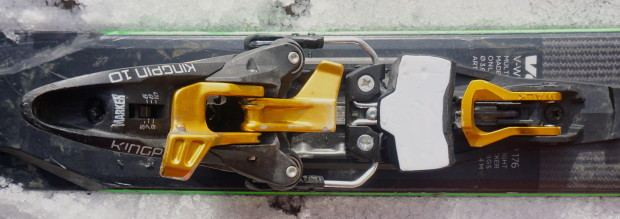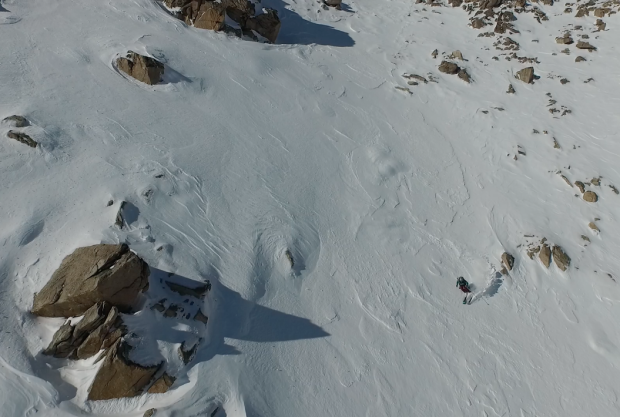[this post is sponsored by evo.com]

Specifications:
Weight: 759 g, 768 g
DIN Range: 5 – 10, 6 – 13
Ramp Angles: 0, 7 deg, 13 deg
Break Widths: 100 mm, 125 mm
Crampon Widths: 90 mm, 105 mm, 120 mm
Pick up a pair of the Marker Kingpins at evo.com: 2016 Marker Kingpin
Heads turned as Marker unveiled the Kingpin at the 2014 trade shows. As a combination of a tech toe and alpine-like heel, the Kingpin is worthy of being called a “game changer” in the tech binding marketplace.
The Kingpin consists of a tech toe with a lock-out function for touring and a pinless alpine-like heel on a track with a ski/walk level. The heel has two risers, 7 deg and 13 deg as well as a flat tour option. It comes standard with 100 or 125 mm breaks and you can buy a breakless heel pad separately. The toe piece comes with a small hole in the front molding that you can thread a leash through. The heel has a large AFD plate and roller bearings for reliable release with bulky AT soles. At $649 and 730g for the burlier 13 DIN option, both the weight and price are pretty much a split down the middle between the Dynafit Beasts ($749, 795 g) and Radicals ($525, 595 g). A pretty good deal considering the Beast is the Kingpin’s main competitor in performance.
Toe
The kingpin toe piece resembles other tech toes, but has an extra set of springs that Marker dubs “the six pack.” These extra springs help the toe absorb more vibration, making it feel more stable in chopped up terrain and decreasing the likelihood of pre-release. Small metal tabs in front help position your boot for easy entry into the binding as well as aid your boot in a circular rotation for a cleaner release. Obvious, but worth stating, the tech toes are much more ergonomic and easier to walk on compared to the Marker Duke or Salomon Guardian since the pivot point is closer to the toe.
Heel
The Kingpin heelpiece is where Marker sets themselves apart from the rest of the tech binding market. The Kingpin is the first tech binding without heel pins, which is a huge improvement for two reasons. First, there is a vertical gap between the pins and boot fitting, meaning that you don’t get direct force transfer to the tails of your skis. If you try to engage your tails, you have to go through a dead zone before the pins touch your boot. Dynafit decreased that dead zone significantly in their Beast binding, but didn’t eliminate it completely. Second, the standard tech heel pins are only 2cm apart, whereas the Kingpin has a 6cm wide contact length with the back lip of the boot, increasing the torque threefold and significantly increasing power transfer to the ski. Because of the pinless system, these bindings require adapters for boots with shortened soles like the Dynafit TLT 5, 6, and a handful of others. Like in alpine bindings, the Kingpin heel has a vertical release spring that provides the binding with elasticity and 16 mm of travel, which is much more than some lower end alpine bindings and much much more than all other tech bindings.
Release-ability
The Kingpin in one of only two bindings to receive the DIN/ISO 13992 certification (Dynafit Beast being the other.) This certification means that the binding was tested to perform in a predictable manner in order reduce the likelihood of lower leg injuries (although not necessarily knee injuries) with an AT boot sole that is also ISO certified. It is worth noting that uncertified bindings could release just as dependably, but were not tested; and certified bindings could release unpredictably with an uncertified boot. It is also worth noting that the Kingpin’s DIN certification is different from the DIN certification used for alpine bindings and they do not release like alpine bindings. Alpine bindings have lateral release in the toe and vertical release in the heel. Like other tech bindings, the Kingpins have both lateral and vertical release in the heel. This doesn’t mean they are less safe than alpine bindings, they just work differently.
Performance
I skied 30 days on the Kingpins in all sorts of conditions. Groomers, powder, corn, and re-freeze. I’m used to skiing free-ride specific tech bindings and the difference was night and day. The power transmission was next level, especially to the tails of the ski. They excelled in different conditions like end of the day groomers, corn, and chopped up powder, but not as well when it came to re-freeze, I could feel every bit of chatter in my feet, and it became obvious that I was skiing a tech binding. I never felt like locking out the toes, even through all the chatter and even took a couple spills with no issues releasing. Although I didn’t have any problems pre-releasing while skiing, I did come out of the locked toes in tour mode quite a bit while walking on icy terrain.
The bindings felt easy to step into with the toe guides and I haven’t yet had issues with the ski/walk track icing up, which is promising. The toe lock out lever is easy to flip up with the pole handle for touring and the risers take me some fumbling to raise with pole baskets, like other tech bindings. Marker had to recall the first production round of toe pieces due to pins becoming loose; they identified it as an assembly error, which they fixed along with increasing quality control. My toe pins were of the next production round and I never had any issues with the pins or felt unsafe.
Pick up a pair of the Marker Kingpins at evo.com: 2016 Marker Kingpin





I just purchased a pair of DPS 112 Pure Wailers & a pair of DPS 99 Pure Wailers.
Clearly the 99’s will be used on the East Coast much more often than the 112’s. I have decided on a Kingpin 13 tech Binding for the 112’s & wanted to know about there reliability for normal everyday Alpine skiing on the East Coast (VT, NH , etc..) Is the Kinpin Binding a reliable binding for my everyday skiing ?
I don’t want to have to buy 2 pairs of boots to accommodate 2 different bindings – depending on which skis I decide to ski on any giving outing.
I know all of that.
I know all there is to know about the Kingpin 13
My question is – How reliable is it on Everyday Northeast Alpine Skiing.
From groomed to ice, packed snow,etc.. Also- Will the Binding hold in Moguls, etc..
Its a Backcountry Ski binding That I would like to use for Alpine Skiing at the resorts o the Northeast as well